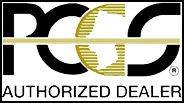Clad Coins’ Golden Anniversary:
Copper Nickel Coinage Deserves More Attention
Copper Nickel Coinage Deserves More Attention
Posted: MAY 28, 2015 (From COINage Magazine June, 2015 Edition)
I had an epiphany at a Wawa convenience store the other day. Maybe it was a hoagie-induced realization, but nevertheless I found myself staring in quasi amazement at what I held in my hand as I reflexively checked the change from my sandwich order. I found a 1965 Washington quarter.
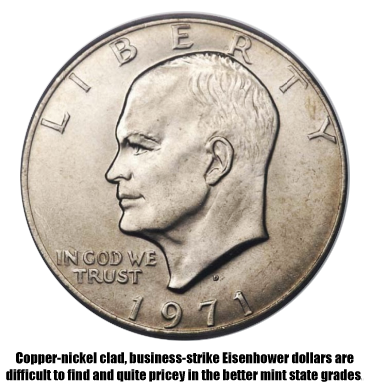 What’s the big deal, you ask? It’s a 50-year-old coin – something I hardly ever had the pleasure of finding when I first began collecting coins in 1992, when I was 11 years old. U.S. copper-nickel coinage is now half a century old, and it’s a golden anniversary that it seems some numismatists might not be very enthusiastic about celebrating.
What’s the big deal, you ask? It’s a 50-year-old coin – something I hardly ever had the pleasure of finding when I first began collecting coins in 1992, when I was 11 years old. U.S. copper-nickel coinage is now half a century old, and it’s a golden anniversary that it seems some numismatists might not be very enthusiastic about celebrating. However, if you ask me, I think copper-nickel coinage is aging into its advanced years rather gracefully.
Back in 1992, when I first ventured into the hobby, the copper-nickel era was still in its relatively youthful 20s. In those days, 50-year-old coins would have been from the World War II era, but never did I find random "Mercury" dimes or Walking Liberty half dollars turning up in my pocket change in the mid 1990s.
To this point, I still haven’t seen any Mercs or Walkers traipse into my hands during a cash transaction. (Change-checking disclosure: I have turned up several 1940s Lincoln cents in regular transactions, and I even discovered a 1943 war nickel at a fast-food restaurant a few years ago. But that’s about it for my WWII-era circulation discoveries).
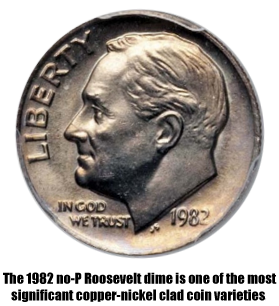 I'd have been pretty ecstatic if I found 50-year-old wartime coinage in 1992 as routinely as I find 50-year-old copper-nickel coins today. Yet, here I am, giving a common 1965 copper-nickel clad Washington quarter more than a passing glance.
I'd have been pretty ecstatic if I found 50-year-old wartime coinage in 1992 as routinely as I find 50-year-old copper-nickel coins today. Yet, here I am, giving a common 1965 copper-nickel clad Washington quarter more than a passing glance. Perhaps we numismatists should give copper-nickel coins a little more attention. And what better time to do it than now, during the 50th anniversary year?
If you think about it, there’s a lot about copper-nickel coinage that should excite collectors. There are scarce coins. Varieties. Errors. Conditional rarities. You name it.
Let’s take a look at copper-nickel dimes, quarters, half dollars, and dollars and talk about some of the many interesting finds that await you among the clad versions of each of these denominations.
CONSIDER THE SATISFACTION you’ll enjoy finishing off a 1965-to-date album of Roosevelt dimes – a series that ranks as a definite sleeper in the minds of many numismatists and can be completed as a 1965-to-date set, with all basic mint state and proof varieties, for under $300.
One of the more interesting issues is the 1996-W dime. This West Point surprise was struck as a bonus piece that came with regular 1996 uncirculated sets. The coin was never intended to circulate, but I’d still suggest keeping your eyes peeled for one in pocket change anyway. After all, we know what can happen when coin collections wind up in the hands of people who aren’t necessarily attuned to the values of coins.
Coins such as the 1996-W dime often “escape” in vending machines, grocery stores, and candy shops. An uncirculated 1996-W Roosevelt dime is worth around $20, which is about the price you’d expect for a modern coin that was struck to the tune of just 1,457,949 pieces.
But if you're seeking bigger return, why not set your numismatic sights on the 1982 no-P Roosevelt dime? That inadvertent variety is a truly scarce modern coin and sells for $300 in MS-65. It surely ranks as a major prize among copper-nickel U.S. coins. What’s more, it can still be found in circulation.
According to the Professional Coin Grading Service (PCGS), no more than about 75,000 of the 1982 no-mintmark Roosevelt dimes were made, based on the typical life expectancy at that time for a die pair. So, given the scope of modern-day coinage, which is made by the tens of millions each year, the 1982 no-P is a no-kidding treasure.
In exploring scarce copper-nickel clad coins, I spoke with Mitchell Spivack, one of the foremost experts on modern U.S. coins and owner of Wondercoins™ (www.wondercoins.com). Spivack has been collecting coins since the 1960s and has been enthusiastically pursuing copper-nickel clad coins for more than 30 years.
If you’re looking for condition rarities among Roosevelt dimes, Spivack says they are ripe for the (cherry) picking. He believes one area of significant interest should be the full-torch-band examples.
“Many clad Roosevelt dimes have a mushy strike,” he explains, contrasting the overall lackluster quality of the copper-nickel clad pieces with their relatively sharper pre-1965 silver predecessors.
“I can’t even locate any 1969, ’70, or ‘71s (Philadelphia-mint dimes) with full bands.”
There are only seven PCGS-graded 1977-D's with full bands in MS-65, and similarly paltry figures relate to the number of full-band issues for several other dates among clad Roosevelts.
“Some dates,” Spivack says, “like the 1974, have never seen a full-bands designation from PCGS."
Spivack compares the collecting of full-torch-band Roosevelt dimes with the pursuit of full-step Jefferson nickels as an area of interest that appeals to many series specialists.
“The opportunities are virtually endless,” he exclaims.
AS FOR COPPER-NICKEL CLAD QUARTERS, let’s start with 1982 and 1983 issues. Go ahead. Try and find some in pocket change. You probably won’t. Not right away, at least. That’s because they’re rapidly being pulled out of circulation by coin collectors.
What make those two dates so special?
As you might know, the reason for the relatively high values of those quarters is the absence of government-issued mint sets during those two years. Most people didn’t set aside any uncirculated rolls or bags of quarters back in the day, either – probably because of the ironic speculation that those would be common coins. So what we now have are modern-day copper-nickel clad key dates.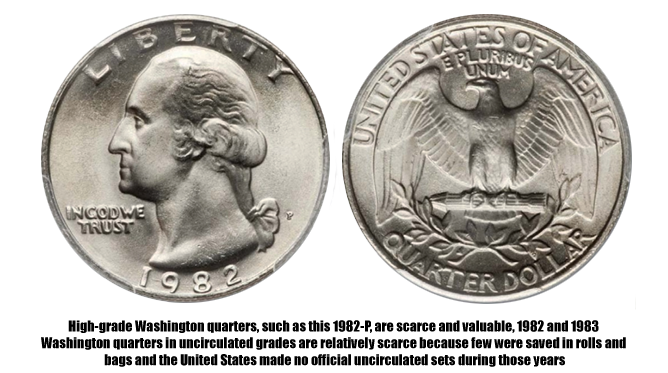 The 1982 and 1983 Washington quarters are actually worth more than face value in circulated grades. I was even offered $4 by a local coin dealer for an About Uncirculated 1983-P quarter I happened to find in the change from a snack vending machine a few years ago. Uncirculated specimens of the 1982-P, 1982-D, 1983-P, and 1983-D cost $5 to $15 each – or more.
The 1982 and 1983 Washington quarters are actually worth more than face value in circulated grades. I was even offered $4 by a local coin dealer for an About Uncirculated 1983-P quarter I happened to find in the change from a snack vending machine a few years ago. Uncirculated specimens of the 1982-P, 1982-D, 1983-P, and 1983-D cost $5 to $15 each – or more. By the way, if you want to obtain uncirculated U.S. coins from 1982 or 1983, one of your best bets may be to buy mint souvenir sets from those two years. Souvenir sets were sold to visitors at the Philadelphia and Denver mints and contain a single example of each circulating denomination struck at the respective mint, plus a medal from that facility.
You could buy only Philadelphia souvenir sets at the Philly mint and only Denver sets at the branch in the Mile-High City. I’ve bought these sets in the aftermarket for my collection, and they cost me a pretty penny years ago. I see today that they’re each selling for about $50 and up on eBay.
Not to be outdone for sheer scarcity are the 1986 quarters, which are also harder to come by in uncirculated grades than most of their copper-nickel clad counterparts. Each sells for $4 to $5 in MS-63, which is a marked notch higher in price than the majority of other cupronickel quarters in the same grade.
Spivack has been aggressively seeking clad Washington quarters since 1983. As he has long come to realize, there’s a huge dearth of high-end mint state Washington quarters out there.
The clad coin guru should know: He’s not only served for nearly a decade as a PCGS outside expert for modern coins but also has received a Hall of Fame Award from PCGS for his stellar Registry Set collection of Washington quarters dating from 1932 to date.
“It’s not that people haven’t taken the time to look for these coins – they have,” Spivack says of better-quality copper-nickel clad issues. “They are simply scarce.”
He says he’s been pursuing sealed $1,000 bags of copper-nickel clad Washington quarters for decades and has come up virtually empty handed.
“I am aware of a mint sealed bag of 1983-P quarters that yielded a single MS-67 specimen," he relates. "There have been a total of six certified at that MS-67 level to date by PCGS.”
Spivack, who is a self-proclaimed fan of condition rarities, says there are several other Washington quarters to keep an eye out for besides the 1982, 1983, and 1986 issues.
“The 1969, 1971, 1985, and 1988 (Philadelphia) quarters all have very low populations in MS-67,” he says, pointing to current population figures as low as three or four each for those dates.
He also cites the 1991-D and 1994-D quarters as being among that select group of pieces that are truly scarce in MS-67.
Spivack can personally attest to the elusiveness of these coins: He says he and many others have been looking for them for years – decades in the case of the older ones.
“In many cases, copper-nickel Washington quarters are as scarce in MS-67 as classic coins are in similar grades,” he says.
He attributes the lack of MS-67s to the clad coins' relatively poor strike quality and subpar handling, because of which many of these coins are inferior in eye appeal to their earlier silver cousins.
Further compounding the challenge of finding premium-quality clad quarters is the absence of 1960s, 1970s, and 1980s mint-sealed bags of quarters.
“I suspect many of them likely went to the casino industry, which used to operate slots with quarters,” Spivack observes, surmising that the casinos likely snapped up huge quantities of freshly minted quarter dollars years ago.
“Not only are bags scarce," he says, "but so are fresh unsearched rolls now.”
Among Spivack’s favorite clad quarters are the 2004-D Wisconsin extra-high leaf and low leaf varieties, which have populations of two and three, respectively, among MS-67 PCGS-graded specimens.
Thanks to the addition of the 50 States Quarters and America the Beautiful national park quarters since 1999, the entire set of copper-nickel clad Washington quarters has become quite large. Completing a standard collection with all the basic varieties of run-of-the-mill mint-state and proof quarters since 1965 would cost roughly $1,000 if silver issues were included.
BUT WHY SHOULD THE CLAD coin collecting fun stop at quarters? Uncirculated Kennedy half dollars are also difficult in the upper grades.
Like the previously mentioned quarters of those dates, 1982 and 1983 Kennedy halves are relatively scarce in brilliant uncirculated grades, with the 1982-D and 1983-P particularly hard to come by. Those two pieces retail for $20 each, with the 1982-P and 1983-D halves selling for slightly lower prices.
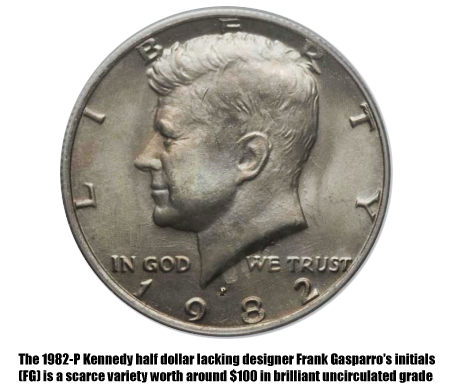 And while I’m talking about 1982 Kennedy halves, I can’t fail to mention the 1982 no-FG half. This variety, missing the initials of the coin’s reverse design artist, Frank Gasparro, is worth $100 in MS-65 and can be found in circulation, whatever “circulation” means for half dollars these days (perhaps a life of stagnation in bank rolls?).
And while I’m talking about 1982 Kennedy halves, I can’t fail to mention the 1982 no-FG half. This variety, missing the initials of the coin’s reverse design artist, Frank Gasparro, is worth $100 in MS-65 and can be found in circulation, whatever “circulation” means for half dollars these days (perhaps a life of stagnation in bank rolls?). Spivack is also a big fan of high-grade mint state Kennedy half dollars which, like virtually all other clad issue, are extraordinarily elusive in the "pop top" grades.
“For a basic PCGS Registry Set of Kennedy half dollars, mine is in the Number 2 spot,” Spivack says proudly.
“There are some really tough condition rarities out there,” he adds. "The 1971-P, for example, is a very tough coin in MS-66+ or MS-67 grades with only nine in those grades.”
He rattles off other scarce dates, such as the P-mint Bicentennial clad, half dollar, with an MS-67 or higher population of just 14. And only seven MS-67 1982-P halves are known to exist, with none higher.
“The list goes on,” Spivack says, “and many dates are extraordinarily elusive in grades of MS-67+ and better.”
I took a peak at eBay sales data to see what Kennedy halves are going for in those upper mint state grades. A 2013-D grading MS-68, which has a current population of four with none higher, sold for $2,000. A PCGS 1982-D in MS-67 went to a bidder for $1,050. And a business-strike 2005-D in MS-68 housed in a PCGS slab claimed a top bid of $970.
Even if you can afford only the Choice BU and typical proof material, a 1964-to-date Kennedy half dollar collection (which, yes, does include the 90-percent-silver 1964 and 40-percent-silver 1965-to-1970 halves) is another great set that would look fantastic in any coin collector’s holdings. Expect to pay anywhere between $1,000 and $1,300 for such a set.
WHAT ABOUT BUSINESS-STRIKE Eisenhower dollars? They’re huge coins that have always tickled my numismatic fancy. Unlike anything we see in circulation today, they represent a transitional chapter in U.S. coining history - for when in 1971, they married the 38.1-millimeter-diameter of the classic silver dollars with the copper-nickel clad reality of a high-inflation, Space Age era.
Spivack says Eisenhower dollars are indeed another excellent avenue for the collector.
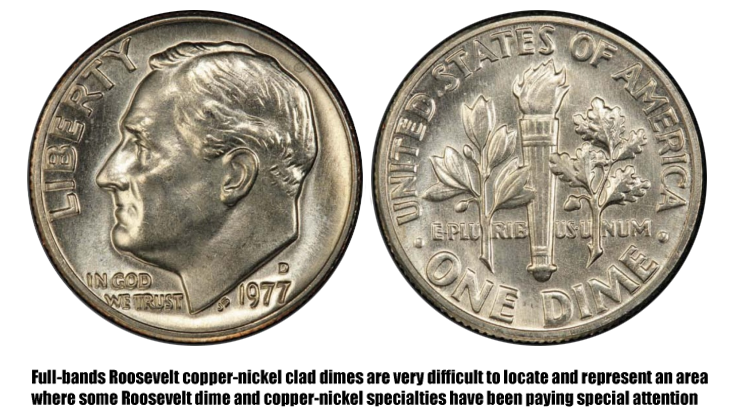 “Many dealers are paying a little more than face value nowadays for circulated 'Ikes' – between $1.07 and $1.12 each,” he reports.
“Many dealers are paying a little more than face value nowadays for circulated 'Ikes' – between $1.07 and $1.12 each,” he reports. But worn Ikes certainly aren’t the only thing collectors should be looking for. Copper-nickel clad business strikes are quite tough in MS-65 and honest-to-goodness scarce in MS-67.
One of his favorite Eisenhower dollars is the 1972 Type II reverse, which shows sharper definition in the date and inscriptions.
“They’re difficult in MS-65 and downright scarce in MS-66, with only seven certified by PCGS in that grade,” he explains. “In MS-66, the 1972 Type II is one of the crown jewels of the clad mint-state coins and, in my opinion, has a value of $15,000 to $20,000.”
Further investigating the (barely there) availability of high-end Ikes, I turned to eBay data. Among early 2015 sales, I found a PCGS certified 1974 MS-66+ sold for $3,250. A 1978-D CAC-stickered MS-66+ in a PCGS slab changed hands for $2,950. A 1976-D Type I graded MS-67 by the Numismatic Guaranty Corporation of America (NGC) went for $1,392.
Spivack says there are many opportunities for collectors who want high-end deep cameo Ikes in proof grades.
“Sure," he says, "there are eight known ‘73 clad proofs in a grade of Proof-70, and they probably would fetch about $5,000 to $9,000 at today's levels" (There has already been a reported auction sale of one of them in excess of $9,000.)
But what about super ultra-deep cameo Proof 69s?
“Those are exceedingly difficult for a year like 1973 in clad and yet these ‘monster, two-sided deep-cameo’ coins aren’t even recognized by the top grading services."
"So, there’s an opportunity for coin collectors to cherrypick already graded PR-69 DCAMs which may cost $25 to $50 each, and find themselves proof Ikes with truly monster-quality two-sided deep-cameo contrast."
Those ultra-deep-cameo Proof-69 Eisenhower dollars, he says, are cherrypicking bargains just waiting to be found.
A complete basic PDS set of Eisenhower dollars can be finished with just 32 coins and for well under $500 in the typical mint-state and proof grades. Or, you could aim to finish a top-of-the-line Registry Set of Ikes, though that could take years to finish and potentially hundreds of thousands of dollars to tackle in earnest.
SINCE I'M TALKING ABOUT copper-nickel coins, I’ve got to bring up what may be one of the most publicly disdained pieces of the last 50 years: the Susan B. Anthony dollar.
It’s a coin that, if it walked into a bar while wearing jeans and a T-shirt today, would probably not be carded anymore, given its 30-something age now. It’s also a coin that has the less-than-endearing nickname of “The Carter Quarter” because countless people mistook the 1979-to-1981-vintage coins as 25-cent pieces, usually meaning a loss of 75 cents with each such occurrence during cash transactions.
Hold a common clad Washington quarter and SBA dollar in your hand simultaneously and you’ll see the problem most non-numismatists would have had – not surprising, given that the SBA’s diameter is just 2.2 millimeters wider than the similar-looking quarter.
The Susan B. Anthony dollar was supposed to be a success story, and with its depiction of the famous women’s suffrage leader, it sent an approving nod to the feminist social movement of the 1970s, which included the push behind the still-unratified Equal Rights Amendment.
However, the coin, like the ERA, failed to generate enough support to stick around, and the SBA kicked the bucket the same year interest rates soared to 20 percent and lights dimmed at disco clubs across the country.
It was 1981, and the Susan B. Anthony dollar coin was so unpopular that it wasn't even made for circulation that year. Few SBAs had fared well in commerce channels to begin with.
As we would later come to witness, "Susie B's" returned for one last hurrah 18 years later, in 1999. It was a different time, a different era. By then, the SBA – a coin relegated by the millions to the dark recesses of Federal Reserve vaults – had found new life in postage stamp vending machines and subway change booths.
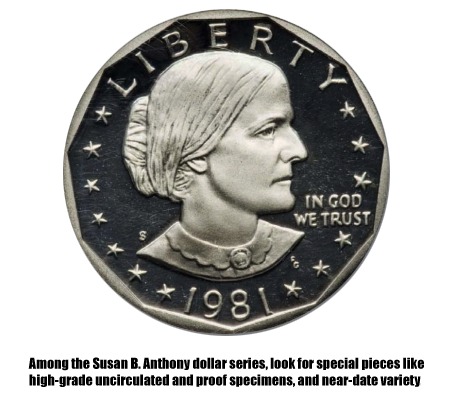 America was running out of Anthony dollars, and more were needed to bridge the gap a year before the Sacagawea dollar would roll off the presses in 2000.
America was running out of Anthony dollars, and more were needed to bridge the gap a year before the Sacagawea dollar would roll off the presses in 2000. Now, how could a coin with an interesting story like the SBA’s not prompt a numismatist to go out and spend $2, maybe $3, on a gem specimen, if for nothing else than to keep as a shining example of one of the most infamous failed U.S. coins in history?
Notwithstanding its unpopularity, the SBA dollar has several pluses to offer collectors. The 1979 “near date” variety, which shows the date almost touching the rim, is priced at about $30 in MS 65. Both the 1979-S and 1981-S Type II dollars, which exhibit clearer “S” mint marks than their respective Type I proof counterparts, are worth $85 and $225. And the 1999-P proof, which has a relatively low mintage of 750,000 pieces, is worth $20.
Spivack adds: "There is a premium already on 1981 Susan B. Anthony dollars, especially on the 1981-S coin. However, locating a 1981-S SBA in true MS-67 quality is extremely difficult.”
He points to the condition scarcity of the '81-S.
“PCGS has graded just two specimens in MS-67 since they opened for business in the 1980s,” he notes. “I personally graded one of those two coins last year and it took me about 30 years on the hunt to finally locate a single 1981-S specimen worthy of that grade."
ARE COPPER-NICKEL COINS sounding more interesting to you?
Standard date-and-mint-mark collecting is very enjoyable, and something I’ve done and still do for many different series. But surely, there are many ways to help turn the pursuit of collecting copper-nickel clad coins into more than a simple game of filling holes in folders or albums.
Copper-nickel clad coins, like many of the classic coins of yore, offer exciting avenues that include high-grading gems, relatively low-mintage key dates, interesting varieties, and Registry Set wonders.
Meanwhile, Spivack recommends collectors to be on the lookout for coins that most hobbyists hasn’t followed much yet.
“Educate yourself to hunt for the things that are off the radar screen,” he says.
He offers insights, for example, on the enormous opportunities that can be found among the “monster proofs” from the early 1970s.
“Many people are already looking for deep cameos on the 1964 through 1972 proof coins,” he says. “But what we don’t often see are the ultra-deep-cameos on 1973 through 1976 clad coins in top grade."
At that time, the U.S. Mint was just transitioning into proof manufacture that consistently resulted in deeply frosted devices.
"I mentioned previously just how scarce a monster deep-cameo, two-sided clad Ike dollar from 1973 is to locate," Spivack says. "Likewise, a great challenge is trying to locate a near-perfect to perfect quality 1973 or 1974 clad quarter proof with spectacular two-sided monster deep-cameo surfaces."
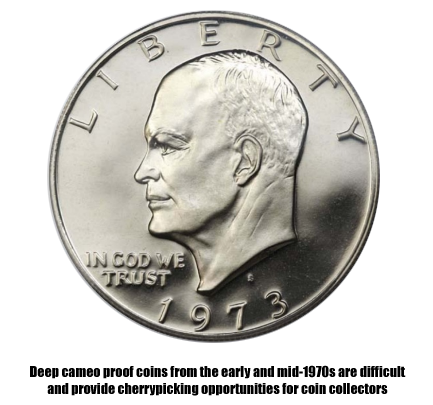 Remember, he adds, an ultra-deep-cameo proof from 1973 or 1974 won’t look like ones from the late 1970s and early 1980s. The key? He stresses the importance of looking at many coins from a selected era and becoming acquainted with the usual characteristics of those pieces. That, he says, will help you spot the pieces with that extra kick of cameo effect or other desirable qualities.
Remember, he adds, an ultra-deep-cameo proof from 1973 or 1974 won’t look like ones from the late 1970s and early 1980s. The key? He stresses the importance of looking at many coins from a selected era and becoming acquainted with the usual characteristics of those pieces. That, he says, will help you spot the pieces with that extra kick of cameo effect or other desirable qualities. “Go to a coin show and ask to browse 20 or 30 proof sets from 1973 or 1974 and look for those with coins exhibiting deep cameo surfaces on both sides of the coin,” he suggests.
“With early and mid-1970s proof sets selling for $5 to $10 these days, you could potentially find yourself some incredible specimens for the equivalent of a dollar or two each.”
“If I had to pick my favorite coin in my entire classic and modern coin collection," he adds, "it would surprisingly be a post-1964 coin. I am referring to the 1976 no-S silver Type II proof Eisenhower dollar.”
“This coin was struck in connection with honoring the 200th anniversary of our great country, is believed to be unique, and is a silver proof Ike with the Type II reverse format. The coin currently has a PCGS price guide value of $450,000 making it the most expensive post-1964 United States coin I am aware of.”
 Another outstanding clad coin Spivack holds in awe is the 1975 no-S proof Roosevelt dime.
Another outstanding clad coin Spivack holds in awe is the 1975 no-S proof Roosevelt dime. “Two are known, and the last time one was sold at auction I believe the price was $349,600, as that is the current price showing in the PCGS price guide today.”
"In my opinion," he adds, "coins such as the 1976 no-S silver Type II Ike as well as the 1975 no-S proof Roosie will be the great absolute rarities of the 1965-date era and will put a spotlight on many of the other condition rarities of the same time period, including many clad examples.”
SPIVACK SAYS HE'S GLAD to share his insights with today’s generation of coin collectors because he wants to educate numismatists about the incredibly exciting avenues that can be explored within the body of clad coinage.
“I’ve been passionate about clad coins since I first concentrated on them in 1983,” he declares, reminiscing about the many modern numismatic wonders he’s seen in the last three decades.
“The period of time we’re in now is probably like the early 1960s, when one could go to the bank and cherrypick rolls and bags of Morgan Dollars for great finds,” he remarks.
“I was just a very young kid back then and, in fact, too young to participate in that great cherrypicking opportunity. But, now is the time to look for those incredibly scarce clad coins while you can still find them without having to pay a fortune for them.”
So, you see? After 50 years, there are many golden opportunities among copper-nickel clad coins for collectors who treasure scarce varieties, condition rarities, and other desirable collectibles.
As a coin collector, I’m always finding excuses to check out a new avenue in this amazing hobby, and as I’ve come to learn over my years as a numismatist, there are plenty of reasons to appreciate copper-nickel clad coins.
So, here’s to 50 years of clad coins. With the prospect of an even cheaper composition increasingly looking like an eventual reality for U.S. coinage, will we even see 50 more years of copper-nickel clad coins?

